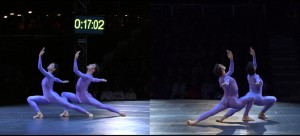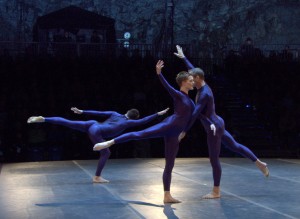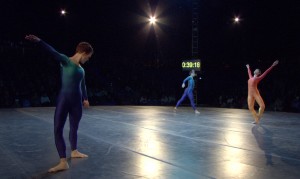By Juliet Neidish
The Whitney Museum of American Art not only revealed its commitment to time-based art by choosing lots of it for its 2012 Biennial, but also extended its definition of the genre beyond de rigueur video and performance installations, to include dance, theater, film and music. With the Biennial still on-going, it’s not yet clear how, if at all, placing these various types of performance in this particular museum setting will affect the viewing experience or the making of such time-based work, other than to expose it to a primarily visual arts-going public.
The selection of Charles Atlas’ film, “Ocean” (2011), was however, an exciting example of how the museum setting can provide an arena that not merely displays a non-static canvas, but actually adds to its fulfillment. Charles Atlas, a pioneer in film and videography, has a long history of collaboration with dance, including having worked closely with Merce Cunningham since the mid-1970s. “Ocean” is a dance Cunningham premiered in 1994, in a theater-in-the round of the Cirque Royal, in Brussels. In 2008, at the age of 89, Cunningham took on the major project of restaging it outdoors, in the huge Rainbow Granite Quarry in Minnesota before an audience of 4,500 spectators. Atlas’ vision was also big: with a 5- camera team he shot all 3 performances to create one vast film mirroring the immensity of both the quarry (the setting of the piece) and the ocean (the subject of the piece). The otherwise bare, 4th-floor Whitney gallery provided a wall- as- screen large enough to match his vision. Light chairs were strewn around for viewers. Only a small amount of light was maintained for the negotiation of audience entrances and exits.

The film begins with the technical crew engrossed in building the theater interspersed with clips of The St. Cloud Symphony warming up. An electronic score by David Tudor merges with Anthony Culver’s Cage-inspired orchestral score played high above the audience by the 150-piece orchestra. We get a strong sense of this massive, open-air quarry into which the circular stage and its apparatus will seemingly have to be placed. Reiterating Cunningham’s conceit that their is no one vantage point from which to view a piece, Atlas, while letting us bask in the piece in its entirety, will also give us cuts from different facings and distances, sometimes splitting the screen to show several views at once. From the minute the first dancer appears onstage, pensively feeling his way through his steps, we know that we are up front and center. And not long after that- side and back and split-screen.

But a marvel of the film is that you sense much more than just closeness. It is grippingly dimensional, heightening your awareness of skin, muscles stretching, and even an eye scanning furtively for an approaching dancer. It made me feel able to see exactly how a dancer’s anatomy was able to work the Cunningham technique. For example, how the power a fully pointed foot when directed into the air was the main dictator of strength throughout the entire body. And how that foot could set off a pulley system allowing the thigh rotating in the hip socket to turn the whole body over to face a different direction. The skin-tight ocean-blue spandex unitards worn by the 13 dancers, both revealing and encasing their muscles, also led the eye in this kind of body reading. The Atlas camera work allowed me to see when a dancer was not totally “on their leg” and how they negotiated to correct or deal with imbalance. This, of course, is part of a dancer’s prowess as a performer, and the piece does go on for 90 minutes without stop, but it is rare to feel almost as if you are in the dancer’s brain following their every move. This 2008 manifestation of the nearly 60 year-old Merce Cunningham Dance Company was a strong one. The dancers breathed as one, phrased as one, and all the while offered glimpses of their own, individual presences.

Having recently seen the Martha Graham Company, I began to think about why Cunningham dancers stay so fresh, so aesthetically contemporary, yet adhere to all that has marked the Cunningham dancer throughout the decades. The current leadership of the Graham Company seem to have concluded that an audience today won’t “get” Graham, unless it is jacked-up to a frenzied pace, performed with an intent to indicate and underline its narrative, and even to parody and comment upon itself while it is being danced. The result produces something quite different from the weight, timing, and abstraction, which has historically communicated story and subject so uniquely and poetically. The Limon Company, which has tried to stay religiously traditional, has in effect locked out a contemporary connection to who they are today and as a result, often appears staid or old-fashioned. The Cunningham dancers up until now have maintained vibrancy without making overt alterations to the fundamental tenets of the Cunningham technique. Now that the company has officially disbanded as of December 31, 2011, according to the plan formulated by the Cunningham Trust in concurrence with the wishes of Merce Cunningham before his death in 2009, we will have to wait to see how the effects of the Cunningham presence will continue to extend into the future.

I agree that it was an amazing film and the setting was perfect for it. I will not forget that experience. Thank you for rendering it so beautifully.
Ooh how exciting San-I just did an on-line course to get me back into drawing, but I think being part of a group would be so much more creative, but as you say-so great to try it again. I’m going to look out for a little course locally. Lovely! x